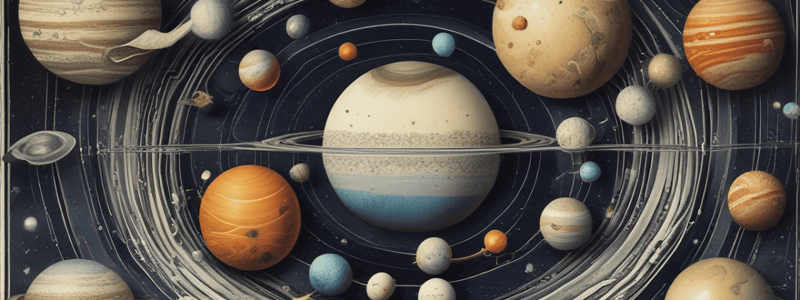Podcast
Questions and Answers
Какому планету соответствует среднее расстояние от Солнца, равное 19.18 астрономических единиц?
Какому планету соответствует среднее расстояние от Солнца, равное 19.18 астрономических единиц?
- Уран (correct)
- Венера
- Меркурий
- Земля
Какой спутник Сатурна является вторым по величине в Солнечной системе?
Какой спутник Сатурна является вторым по величине в Солнечной системе?
- Энцелад
- Фобос
- Тритон
- Титан (correct)
Какой объект описывается как один из самых ярких объектов, видимых с любого места на Земле, и четвертым по яркости на небесном своде?
Какой объект описывается как один из самых ярких объектов, видимых с любого места на Земле, и четвертым по яркости на небесном своде?
- Энцелад (correct)
- Деймос
- Тритон
- Фобос
Какой планете соответствует расстояние от Солнца в 5.2 астрономических единиц?
Какой планете соответствует расстояние от Солнца в 5.2 астрономических единиц?
Какую планету можно было бы ошибочно принять за имеющую больше воды, чем Луна, учитывая, что на нее падает столько же солнечного света, сколько на Луну?
Какую планету можно было бы ошибочно принять за имеющую больше воды, чем Луна, учитывая, что на нее падает столько же солнечного света, сколько на Луну?
Какая планета в нашей солнечной системе является самой маленькой?
Какая планета в нашей солнечной системе является самой маленькой?
Что делает Венеру наиболее горячей среди всех планет?
Что делает Венеру наиболее горячей среди всех планет?
Почему Уран вращается наклонно?
Почему Уран вращается наклонно?
Какая особенность Марса привела к его прозвищу "красная планета"?
Какая особенность Марса привела к его прозвищу "красная планета"?
Что делает Юпитер наибольшим по размеру планетой в солнечной системе?
Что делает Юпитер наибольшим по размеру планетой в солнечной системе?
Flashcards are hidden until you start studying
Study Notes
Solar System
The solar system is made up of eight planets orbiting around the Sun. These planets vary greatly in size, composition, temperature, and distance from the Sun.
Planets
Mercury
Mercury is the smallest planet in our solar system. It has a dense core with few craters, suggesting that it may have had high volcanic activity early in its history.
Venus
Venus is similar in size to Earth but is much hotter, due to a thick atmosphere trapping heat like a greenhouse effect.
Earth
Earth is the third planet from the Sun. It's unique among all planets in its solar system by having a diverse range of environments including oceans, forests, deserts, and polar ice caps.
Mars
Mars is often called the red planet because of its reddish appearance. Its surface features large volcanoes and canyons.
Jupiter
Jupiter is the largest planet in the solar system. It has several distinct rings and large number of moons, most notably Io, Europa, Ganymede, and Callisto.
Saturn
Saturn is known for its prominent ring system composed mostly of chunks of ice.
Uranus
Uranus rotates on its side due to a collision with another celestial body early in its history.
Neptune
Neptune is the furthest known planet from the sun in the solar system.
Moons
Our solar system has many moons, some big, some small, some rocky, some icy, and some gas giants. Some notable moons include:
Earth's Moon
The moon is Earth's only natural satellite. About one quarter of the Earth's surface is covered by ocean, which might lead you to think there would be more water on the Moon because it gets the same amount of sunlight each day.
Phobos and Deimos - Mars
Phobos and Deimos are the two tiny natural satellites of Mars.
Titan - Saturn
Titan is the second-largest moon in the solar system after the moon Ganymede and the seventh largest moon overall.
Enceladus - Saturn
Enceladus is described as "one of the brightest objects visible from any place on Earth, and fourth brightest object in the entire sky.
Triton - Neptune
Triton is the largest of Neptune's 14 known moons.
Дistance From Sun
The distance between a planet and the Sun is measured in astronomical units (AU), where 1 AU is the average distance from Earth to the Sun. Here's how far the major planets are from the Sun on average:
- Mercury: 0.39 AU
- Venus: 0.72 AU
- Earth: 1 AU
- Mars: 1.52 AU
- Jupiter: 5.2 AU
- Saturn: 9.58 AU
- Uranus: 19.18 AU
- Neptune: 30.06 AU
Studying That Suits You
Use AI to generate personalized quizzes and flashcards to suit your learning preferences.




